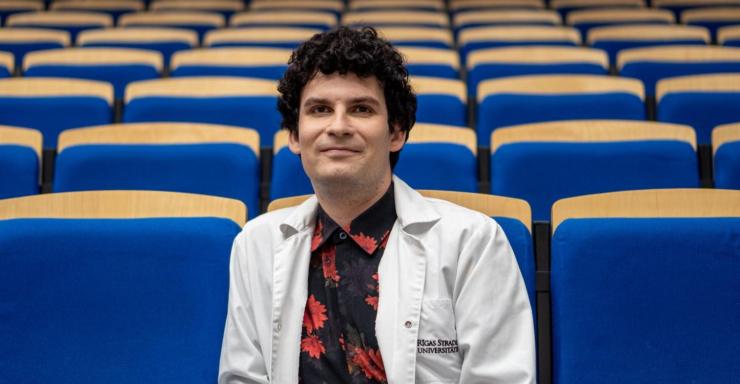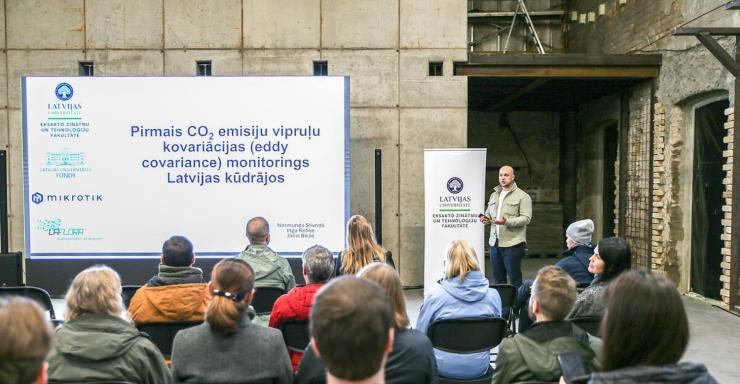Within the European Union co-financed project “European Quantum Communications Initiative”, Latvia is developing the national quantum network “LatQN” to build an experimental national quantum communication network, as well as to develop and test quantum communication technologies in sectors where secure information transmission is particularly critical.
The project’s leading partner and coordinator is the Latvian State Radio and Television Centre (LVRTC). The private sector partner is Tet, the research partner is the Institute of Mathematics and Computer Science at the University of Latvia (IMCS UL), and the public sector partner is the Electronic Communications Office of Latvia (SIA “Elektroniskie sakari”). The total project budget is € 8 million, and the national quantum communication network is expected to be operational within the coming months.

"By the end of the year, we will have a fully functional Quantum Key Distribution (QKD) network – not just a one-time setup in a laboratory or within a single partner, but a fully operational network used by different partners and devices. Such a result at the very first stage of network implementation is rare in Europe. Typically, this is accomplished by a single organisation using a single manufacturer’s equipment. We have three partners, several QKD equipment manufacturers, each with their own key management system and different encryptors. We have tested long distances and we know exactly what our infrastructure is capable of. We will be able to conclude this project with our heads held high," says Leo Trukšāns, leading quantum encryption engineer at LVRTC and Associate Professor at the Faculty of Computing, University of Latvia.
Especially Important for Sensitive Information
According to Trukšāns, such a network is most needed in sectors that handle highly sensitive data - for example, finance, healthcare, and defence.
"Most likely, these technologies will appear quite soon in critical infrastructure points. But it may take a while before a quantum network connects one post office to another in the countryside," notes Kārlis Siliņš, Head of the Commercial Department at LVRTC.
When asked how broadly this new infrastructure should be deployed, Siliņš explains that implementation will most likely occur in stages — starting with the organisations where secure information exchange is most vital. For instance, Poland’s quantum key distribution network already includes at least 30 connections, linking diverse facilities such as data centres, towers, hospitals, and banks. While it is difficult to estimate the number of nodes required in Latvia, Trukšāns suggests that 10 to 20 nodes could cover the country’s most critical infrastructure points.
Developing a Proprietary Key Management System
Initially, LVRTC built a three-node quantum key distribution network under laboratory conditions, operating as a unified system with long-distance optical connections.
"This is the first non-trivial QKD network in the Baltic States, implemented in the summer of 2024," says Trukšāns.
A trivial QKD network consists of just one pair of devices and a single connection — such an experiment was already conducted by LVRTC and IMCS UL back in 2021.
Typically, a QKD network architecture consists of three layers. One or more quantum key distribution links are supported by trusted nodes (TN) - software elements capable of receiving and forwarding keys across nodes. Several manufacturers offer the required key management systems (KMS) for this.
"We already use Toshiba devices, which include their own KMS. Technically, we could have just used that, but that’s not who we are, especially since we have Toshiba devices, while our project partners use ID Quantique devices and key management systems that are incompatible with each other. So, we built our own key management system and are creating an overlay network that integrates sub-networks from different manufacturers into one unified QKD system," explains Trukšāns.
The new key management system was developed together with his students and is available as open-source software on GitHub.
"There are only six self-developed key management systems in Europe, and one of them was created here in Latvia," emphasises Trukšāns.
Before developing their own KMS and even before acquiring physical devices, LVRTC created a simulator: software that “pretends” to be these key management systems.
"They synchronise keys among themselves - not through quantum effects, of course, but via simple, insecure information exchange. What matters is that we can already provide the same key management service that real QKD devices would, and begin developing QKD-based applications even before deploying the actual infrastructure. For instance, Mikrotīkls used our simulator to build its own key usage system. It’s rare to have a working user-facing service while the physical infrastructure is still under construction. This flexibility lets us gradually replace simulated channels with real ones," Trukšāns adds.
Looking Ahead
Project partners are already preparing new proposals to continue development at the next level.
"It has to continue - quantum technologies are the future," Trukšāns is convinced.
Discussions are already underway not only with Latvian organisations that could benefit from such a network, but also with potential partners in Sweden, Finland, and Estonia, to build a broader regional quantum network.
"We have excellent expertise and talent, but funding remains the main obstacle. EU-level project calls are available, but they typically require around 50% co-financing- a significant challenge. As LVRTC Commercial Director, I must be able to justify such an investment to our shareholders. Yes, quantum-secure communication is relevant to certain sectors, but those sectors also need to allocate funds and recognise that these quantum connections will soon become necessary. That’s not easy - and given the direction of the state budget, such discussions will only get tougher," admits Siliņš.
Preparing for the Quantum Apocalypse
Explaining why quantum communication networks are needed, Trukšāns says their purpose is to ensure secure communication in the future. Currently, both symmetric and asymmetric encryption keys are used to exchange confidential information. Symmetric encryption is still considered secure against quantum computers, but asymmetric encryption relies on mathematical problems that quantum computers will eventually be able to solve.
One simple defence is to lengthen encryption keys. For example, while 2048-bit keys are standard today, doubling their length makes them exponentially harder to crack.
"The number of possible combinations grows astronomically. If a 2048-bit key could theoretically be cracked in one second, a key twice as long would require at least 10¹² seconds - that’s about 27,000 years. So, with minimal effort, we can make the attacker’s job hopeless. Doubling the key length is relatively simple - and even though longer keys take slightly more computing time, modern computers handle that easily," Trukšāns explains.
However, to break such a longer key, attackers would need a quantum computer twice as large, reducing the cracking time from millennia to seconds.
"And that breaks our comforting illusion that a small adjustment can keep our data safe," Trukšāns warns.
The moment when quantum computers become powerful enough to break current encryption standards is referred to as the quantum apocalypse. Moreover, intercepted encrypted data can be stored today and decrypted later - a strategy known as “store now, decrypt later.”
"That’s a real threat. It doesn’t matter much if someone decrypts my grocery payment five years from now - but some organisations exchange information today that must remain confidential for decades, even after quantum computers appear. They should already be worrying about the quantum apocalypse," Trukšāns adds.
Experts predict that a sufficiently powerful quantum computer capable of breaking 2048-bit encryption keys could emerge within the next five years. That’s why researchers worldwide are preparing for this challenge. One of the leading solutions is quantum key distribution, which securely synchronises symmetric encryption keys between two points.
While technically a QKD link can be “eavesdropped,” the devices immediately detect a high error rate, indicating an intrusion attempt. The link only synchronises keys once the eavesdropping stops - guaranteed by the no-cloning principle of quantum physics.
"No one yet fully understands what new possibilities these technologies will bring. A quantum computer may seem like something distant - perhaps guarded in a dark laboratory somewhere in America. But while the computer itself may still be years away, the technologies surrounding it are already developing - including here in Latvia," concludes Siliņš.


